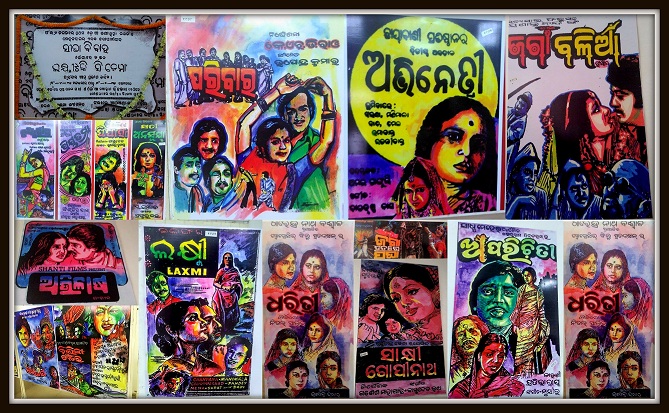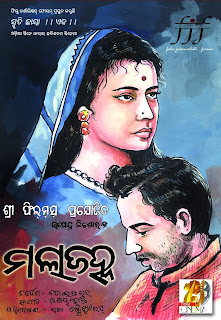The decade between the sixties and the seventies was an exciting time for the country. Despite the war of 65 and internal skirmishes, the nation was placed on the path of progress. And it was evident via the ongoing socio cultural changes in the country. Independent India’s first generation who were born after 1945, were the people thronging the cinema halls. The Odia cinema industry which had become dormant after the very first cinema in Odia ‘Sita Bibaha’, was again raring to go. In 1960, ‘Sri Lokanath’ released at a Puri theatre and became a roaring hit. The makers had rightly gauged the audience’s pulses and the combination of mythological story and common man worked wonders. It was the hit formula through the early part of the fifties which fizzed out in the later years. The audience was just looking for something beyond the stories of Gods and power of the divine. Their search ended with the advent of one of the most versatile actors of the era – Mr. Prashant Nanda.
A seasoned theatre actor, Mr. Nanda debuted through the film ‘Nuabou’. Primarily the story is about the daughter-in-law of a family who gets to resolve the issues of the family using her wits. The audience enjoyed the film very much. Not only it was presented lucidly but it also had managed to touch the chords of the audience through its story of a family which resembled many. The movie went on to receive the president’s silver medal and Mr. Nanda received his first award as an actor.
Then came a flurry of films, each one of which were cinematic gems. Most of them, adapted from the modern day literature and classics, had the audience enthralled. Prabhat Mukherjee directed ‘Manikjodi’ was one of those classics. It spoke about one man’s deep rooted hatred towards another family and how his vengeance seeking mind eventually destroys his loved ones lives. Mr. Dhira Biswal, as the primary antagonist Barada Prassana Pattanaik stole the scene. The songs were chartbusters and the revenge saga was liked by the audience. In 1963, Prafulla Sengupta directed ‘Suryamukhi’ told the story of an idealistic young man, who comes to the city for higher education but goes astray. This movie came into prominence for another reason. It marked the entry of Lata Mangeshkar and Manna Dey as playback singers in Odia.
1964 saw the release of two movies which were an adaptation from literary works. ‘Sadhana’ was adapted from Ashapurna Devi’s ‘Chinnapatra’ where as ‘Amadabata’ was adapted from Basant Kumari Patanaik’s eponymous novel which told the story of a young and much pampered girl who rises to the challenges of life and evolves into a responsible woman post marriage, played by the very talented Jharana Das. This movie was appreciated by the general audience as it portrayed the middle class Odia family and their struggles in life. It also had the hit chartbuster ‘Jibana Jamuna re Juara Uthe re’ which remains a crowd favourite till date. Gauging that a female-centric movie was appreciated by the audience, in 1965, the producers came up with their next offering – ‘Abhinetri’ which had, for the very first time, a double role in Odia cinema, played by Jharana Das. It was again adapted from the works of Kanhu Charana Mohanty.
In 1966, Upendra Kishore Das’s path breaking novel ’Malajhanna’ was adapted into the movie of the same name by Nitai Palit. It depicted the relationship between a married woman and a young man. A story, that broke several stereotypes and touched upon many factors such as casteism and superstition. The heart breaking climax where the protagonist Sati commits suicide, made many eyes moist. The music was delivered by a young man named Akshaya Mohanty, who then went on to rule the Odia music as one of the most versatile music directors ever. In the same year, Ms. Parbati Ghosh, already an established actress of the era, became the first woman producer and presented the movie with the shortest name ever – ‘Kaa’. In colloquial language, it means to pass on or offer your chance to someone else. ‘Kar’ told the story of a woman, who lets her husband marry another woman as she cannot bear him a child but out of jealousy, the second wife schemes to separate them. Based on Kanhu Charan Mohanty’s work, this movie became a massive hit with the audience and went on to earn the President’s silver medal.
Mrinal Sen, an art film powerhouse and a very well known name in the Bengali cinema industry directed ‘Mati ra Manisha’ , adapted from Kalindi Charan Panigrahi’s work. It told the story of two brothers, each having a different set of values and a patch of land, inherited from their late father. Exploring a plethora of themes such as greed,jealousy, social strata difference and the values of the joint family this movie touched the inner chords of the viewer. It won the National film award for being the best film in Odia for the year 1967. The very next year, ‘Arundhati’ directed by Prafulla Sengupta won the same award. It told the story of an Odissi dancer who is claimed to be the dead wife of another man, which eventually turns out to be a case of twin sisters. 1968 saw another crowd favourite ‘Stree’ produced by Parbati Ghosh, which had the hit chartbuster ‘Sanja Sakale Tuma Chabi Khoje’. The family oriented story was deeply appreciated by the audience.
Later years saw advancement in the fields of technology and the filming quality was enhanced. The music industry flourished under the banner of stalwarts such as Akshay Mohanty, Sikander Alam, Balakrushna Das, Pranab Mohanty. The movies became commercially very successful. Despite such advantages, the quality of the movies went downhill due to the lack of depth in screenplay, from which it could never recover fully. Those glorious days of Odia cinema remain elusive till date.. All said and done, the sixties will always be remembered as the era,when Odia cinema made their mark on the national level and brought countless laurels to the state and its film makers.










